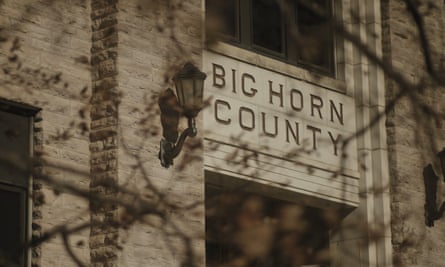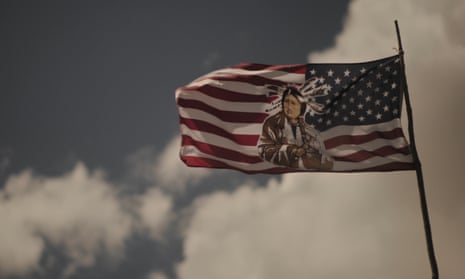Henny Scott was 14 years old, a high school freshman on the Northern Cheyenne Indian reservation in Lame Deer, Montana, when she went missing after a house party in late December 2018. Her family promptly reported her disappearance to the Bureau of Indian Affairs. But the office took two weeks to issue a missing persons report, which “sat on a desk because the individual was out on vacation”, Scott’s mother, Paula Castro, told documentarians Razelle Benally and Matthew Galkin in their new Showtime series Murder in Big Horn.
There was no official search, no amber alert, no communication. “We had to do our own investigation and form our own search crew,” recalled her stepfather, Nathan Stops. Eventually, the FBI stepped in, without notifying Scott’s family, and found her body less than 200 yards from the house where she was last seen.
Nine months later, when 18-year-old Kaysera Stops Pretty Places went missing after a night out with friends in the same county, Big Horn authorities never notified her family of an investigation. Her body was found five days later, spotted by a jogger in a backyard abutting a busy street less than a mile from the Crow reservation where she grew up, but authorities didn’t notify her family for another two weeks.
Both Scott and Places’ cases remain unsolved – Scott’s cause of death was ruled hypothermia, though her family says her body appeared to have bruises and a broken nose and that she was wearing someone else’s clothes. The cause of death for Places was left undetermined. Their families, who both appear in Murder in Big Horn, have been pushing ever since for answers, with little help from or in opposition to law enforcement.
Lackluster responses and languishing cases are the norm for many families of Missing and Murdered Indigenous Women (MMIW), an epidemic in the US and Canada that has in recent years received significant national media attention, though few answers for loved ones. Investigations “usually end up having to be done by the family and the community members themselves”, Lucy Simpson, the executive director of the National Indigenous Women’s Resource Center, told the Guardian. “In so many of these cases, it’s the family that finds their loved one, that does the search to find their loved one because law enforcement doesn’t participate, or doesn’t feel that it’s a priority, or makes excuses based on generally accepted stereotypes about Native people.”
Over three episodes, Murder in Big Horn examines the MMIW crisis in microcosm and in context, through four families still seeking answers and through the history of cultural and physical violence against Indigenous people in the US. Montana has one of the worst missing or murdered rates for Indigenous women in the country – according to a state report from 2017-2019, Indigenous people comprised about 6.7% of the population but accounted for 26% of missing persons cases. Big Horn county, in which 65% of the population identifies as Native American, has the worst rate in the state; by the time Selena Not Afraid disappeared on New Year’s Day 2020, she was at least the 28th missing Indigenous woman in the county for the prior year.
Benally, who is Oglala Lakota and Diné, and Galkin, who is white, began work on the series in 2020 after the disappearance of Not Afraid. The 16-year-old was last seen alive in a broken-down car with friends at a rest stop along I-90, the high-trafficked interstate the cuts through Big Horn county – Montana’s sixth-largest, spanning parts of the Northern Cheyenne and Crow reservations. Her disappearance marked a turning point in anemic public responses; within hours, there were drones, dogs and officers searching for her. Not Afraid’s family camped out at the rest stop, bringing media attention to her disappearance. The New York Times and other national media covered the case. Her body was found nearly three weeks later, less than a mile from the rest stop, in a patch of open land with shrubby grass. Like with Scott, Montana officials ruled her cause of death to be hypothermia.

The grassroots attention for her case, building on outrage over the handling of Scott’s and Places’, represented the “sort of groundswell of advocacy [that] grew to the point that these cases are what got the national attention on the MMIW issue”, Galkin said. Along with sibling producers Ivan and Ivy MacDonald, of north-west Montana’s Blackfeet Nation, Benally and Galkin traveled to Big Horn county to meet family members seeking justice. The film-makers explicitly avoided “extractive storytelling” in which outsiders parachute in, report quickly and leave, and instead “tried our best to tell the story as ethically as possible, and also with honor, to ensure that the families were able to speak their truth”, said Benally. “Because let’s be real, this issue needs a platform, and we needed to ensure that the families had a chance to be heard.”
Murder in Big Horn is thus clear-eyed on the crisis, though less attuned to dire, often faceless statistics than the personal experience of families – Scott’s, Places’, Not Afraid’s, and the loved ones of Shacaiah Harding, who disappeared and was likely trafficked via I-90 in 2018. “These cases are not true crime stories to us. These cases are our relatives,” says Luella Brien, a Crow journalist with Indigenous-led Four Points Press whose aunt Deedee Brien was likely killed – the case was never solved – at 17 in 1977, and whose sons attended school with Not Afraid. “These are not only our sisters, our mothers, our grandmothers, our aunties, our daughters, but they’re human beings,” said Simpson.
The series also examines, episode by episode, the perfect storm of legal, cultural and historical factors which contribute to disappeared women and girls and unsolved, unhandled cases. There’s the immediate factors: the ability of I-90, which bisects Big Horn county, to swiftly move trafficked women and girls out of state. A jurisdictional tangle between state, federal and tribal authorities that allows most cases to fall through the cracks, and prevents the Department of the Interior’s newly formed missing and murdered unit from having sufficient power. (Deb Haaland, the first Indigenous US cabinet secretary, announced the launch of the unit in 2021; it has since faced criticism for inefficiency and ineffectiveness.)

More broadly, there’s the history of violence, discrimination and forced assimilation against Native people by the US government, including the reservation system that, the series argues, was designed for Native Americans to fail rather than thrive. The roots of the MMIW crisis, and pervasive indifference to violence against Indigenous women, are found in the history of colonization and “the lack of respect and humanity that Native peoples have been treated with historically”, said Simpson, which “still have a holdover in a lot of these federal policies, and as well as some of the ways in which our own communities have internalized some of that”.
Whereas most true crime series usually wind through leads and red herrings and contested interpretations, Murder in Big Horn hits a wall early and often: there are no theories, because there was never an investigation. (The Big Horn county sheriff’s office, as well as any active law enforcement representative, declined to participate in the series.) “The mystery is that there’s no mystery,” said Galkin. “If you look closely enough, it’s clear why these things are happening.”
Benally recalled filming during the search for Gabby Petito, a 22-year-old white woman who disappeared while vacationing with her boyfriend in Wyoming, and whose case became a national news and social media fixation in stark contrast to many missing Indigenous women. “As we’re interviewing families and we’re listening to them talk about how there was no urgency from law enforcement to do any sort of search and rescue, to file a missing person’s report, it really had me thinking, ‘Well, what does it take?’” she said. “What does it take for there to be this urgent response from law enforcement, from society, when one of our girls goes missing?”
“I’ll always have hope for some kind of justice,” she added, for the series to reach people who could re-examine the crimes against Scott, Places, Not Afraid and Harding, to “see if there’s something that can be done to find justice for these families. The families deserve some answers.”
Murder in Big Horn starts on Showtime on 5 February with a UK release to be announced
